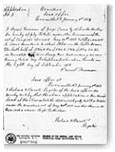

The Homestead Act of 1862 had an immediate and enduring effect on the United States of America and the world that is still felt today. Agriculture, industrialization, immigration, American Indian tribes and prairie ecosystems-all were somehow impacted and forever changed by the implementation of this revolutionary land law.
What are the Homestead Records?
Over the course of the Act's 123-year history, over two million individual homestead claims were made. Each and every one of these claims generated a written record known as a case file that was kept by the U.S. General Land Office. Today, these case files exist only as paper originals and are stored in the National Archives in Washington, D.C. The complete collection of case files created under the Homestead Act contains over 30 million individual pieces of paper. These invaluable documents are subject to natural deterioration, fire and water damage.
To view an original homestead case file and learn more about the kinds of valuable information that can be found in these records, view the Neve case file.
What can I learn from the records?
The paperwork required of homesteaders before they could obtain a patent, or title, to part of the public domain resulted in exceptionally detailed land records. These records describe improvements made to the property, including houses constructed, wells dug, crops planted, trees cleared, and fences built. Some case files mention family members who lived on the land. If the claimant died and a widow or heirs completed the homesteading process, a date of death is given and relationships are explained.
Because military service could reduce the residency period, information regarding such service is sometimes included. Resident aliens who had declared their intention to become citizens provided information about their naturalization process and occasionally even mentioned place of origin. In other words, the land-entry case files of homesteaders are an important source of genealogical information.
What work is being done with the records?
Since 1999, Homestead National Historical Park has been involved in a project that aims to eventually digitize all 30 million documents of the homestead case files collection. Homestead National Historical Park, Fold3.com, FamilySearch, & the University of Nebraska-Lincoln have partnered in an effort to digitize all Homestead Land Entry Case Files housed at the National Archives.
The Homestead Records Project seeks to digitize the over 800,000 Homestead Records from nearly 200 land offices in all 30 Homesteading States. Nebraska records were the first to be digitized, and they are now complete. Ten states have been completed and the other twenty states are currently only availible in hard copy at the National Archives.
How can I find Homestead Records?
All land-entry case files are held by the National Archives in downtown Washington, D.C. If you are researching homesteads in Alaska, Arizona, Indiana, Illinois, Iowa, Nebraska, Nevada, Ohio, Wyoming, and/or Utah, you can search for their homestead records (up to 1908) at the Heritage Center for free. You may also search for digitized homestead records from your own computer on Fold3.com and Ancestry.com, both of which require a subscription for these premium records. Patent information can be found on the Bureau of Land Managment's General Land Office Records website for all states.
You must request records from the National Archives for all homesteads after 1908 or from the non-digitiized states. Learn more details about requesting Homestead Records.